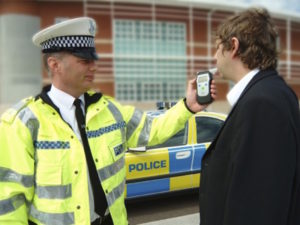Police breath tests set to double this month despite restrictions
Drivers are being warned they are more than twice as likely to be breath-tested in December than any other month – even with lockdown stopping the usual Christmas parties.

In December 2019, 48,804 motorists were stopped by police on suspicion of drink driving; more than double the average figure for the other 11 months
The warning comes from AlcoSense Breathalysers following the start of this year’s Christmas roads policing operation, which launched on 1 December.
Police will be stopping anyone suspected of drink or drug driving, operating stop sites across the country and performing both breath and drug testing.
In December last year, 48,804 motorists were stopped by police on suspicion of drink driving. The average for the other 11 months across England and Wales was 23,043.
And a total of 5,210 drivers tested positive last December (or refused) – a failure rate of 11%.
But this year could see a higher rate; several studies show people have been drinking more alcohol during lockdown, putting them at risk of being caught for morning-after drink-driving. These studies include research published by Drinkaware which showed some people have significantly increased their alcohol consumption at home during the lockdown.
And AlcoSense warned earlier this year that home drinking in the UK is reported to have almost doubled amid the lockdown – while the recent reopening of pubs in some areas and ongoing concerns over public transport during the pandemic could also exacerbate the numbers of drivers taking to the road while over the limit.
Earlier this year, there were renewed calls for a smarter package of measures from the Government to tackle the rising number of drink-drive crashes after latest Department for Transport data showed a 3% rise. The total number of crashes where at least one driver was over the alcohol limit increased by 3% to 5,890 in 2018 – the last year for which figures are available. This is an average of around 16 crashes a day.
Drivers are also being warned of huge variations in drink-drive testing around the country.
New analysis of Home Office data by AlcoSense shows that in North Wales 3,964 motorists were tested last December, whereas in Wiltshire it was just 31.
There were also big discrepancies in the percentage of motorists failing their breath test.
In Northamptonshire, the county with the highest number of tests in England (2,957), the failure rate was just 2%. Whereas in Cambridgeshire, where 1,070 tests were conducted, a worrying 30% were over the limit.
“We might be going to fewer Christmas parties this year, but several studies show that people have been drinking more alcohol during lockdown,” said Hunter Abbott, MD of AlcoSense Laboratories.
“The increase has been driven by job uncertainty and pandemic anxiety, fuelled by the rise in at-home drinking where measures are more generous than a pub or restaurant.
“This trend makes it more likely that people may get behind the wheel and drive with alcohol still in their system the next morning. Even a small amount of alcohol slows reaction time, inhibits judgement and reduces concentration – increasing the likelihood of accidents.
“One in five drink drive convictions are in the morning, but using a personal breathalyser takes the guesswork out of knowing when alcohol has cleared the morning after the night before.”
Drivers caught behind the wheel while above the legal limit face up to six months’ imprisonment, an unlimited fine and a substantial driving ban. Anyone who causes a death while drink or drug driving faces up to 14 years’ imprisonment and this will rise to a maximum penalty of a life imprisonment under Minister of Justice reforms being introduced to Parliament next year.












